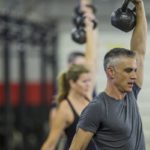
Zachary Mang, PhD
Zachary Mang, PhD
Article Archive
You need both aerobic and resistance exercise. But can doing both in one workout cancel out the benefits? Learn the best way to combine them!
Read MoreProgramming tips to help seniors age not just with grace but with strength through free-weight training and machine-based training.
Read MoreThis article provides you with the evidence-based tools to help clients make a strong start in increasing muscular hypertrophy.
Read MoreThis article will highlight 10 advanced resistance training techniques that improve muscular fitness, strength and mass.
Read MoreResistance training does much more than build strong muscles and bones, but does lifting weights lower blood pressure too?
Read MoreResearchers have focused on three types of periodization training: linear periodization, block periodization and undulating periodization.
Read MoreThe relationship between maximal oxygen consumption (VO2max) and cardiometabolic health is well-defined—resistance training can help.
Read MoreMitochondria are found in every cell of the human body, except red blood cells. These energy-producing organelles play a key role in exercise performance.
Read MoreEndurance athletes have used tapering for years; now there’s evidence that exercise enthusiasts and strength and power athletes can benefit from tapering phases in their resistance training (RT) programs. So, is tapering right for your clients? And when it comes to RT, can less work lead to more success? Here’s what the research tells us.
Read MoreMuch of the periodization literature to date has centered on the strength outcomes and sports performance of athletes striving to balance the needs of practice, conditioning and competition (Bartolomei et al. 2014). But many recreationally active clients seek to gain muscle size in personal training sessions, and few studies have evaluated whether a periodization model should be used in a hypertrophy-focused resistance training program for these fitness enthusiasts. This article highlights the best research available to help answer an important question: Should you periodize a client’s RT plan to maximize skeletal muscle hypertrophy?
Read MoreStrength training (or resistance training) does much more than build strong muscles and bones. Research in the past few years has confirmed that lifting weights changes human metabolism in ways that improve health and well-being. Resistance exercise improves resting metabolic rate and cardiorespiratory fitness. Indeed, some authors call strength training an exercise therapy program (Strasser & Schobersberger 2011).
Read MoreResistance training volume (RTV) is the total amount of work performed during a session of lifting; in other words, RTV = reps x sets x load (the product of repetitions times number of sets times intensity of load) (Figueiredo, de Salles & Trajano 2018). Any one of these variables can be adjusted to increase volume in a resistance training (RT) program. For example, you can increase RTV by performing extra sets of an exercise, adding more repetitions or increasing the weight being lifted.
Read MoreResistance training does much more than build strong muscles. Research has confirmed that resistance training affects metabolism, too.
Read MoreSTUDY REVIEWED: Grgic, J., Schoenfeld, B.J., & Latella, C. 2018. Resistance training frequency and skeletal muscle hypertrophy: A review of the available evidence. Journal of Science and Medicine in Sport, S1440–2440 (18), 30862–64.
Read MoreResistance training for youth can be a polarizing topic, mostly because of misconceptions about safety, injury rates and training techniques. Though parents and trainers alike often worry about the hazards of youth resistance training, research shows that it has a host of benefits—if it’s done properly.
Read More













